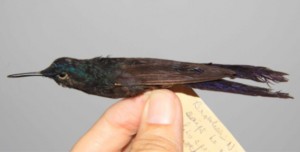Scientists Use 100-Year-Old DNA to Validate Species
/https://tf-cmsv2-smithsonianmag-media.s3.amazonaws.com/filer/prettybirds.jpg)
Scientists, including the Smithsonian's Gary Graves, recently used nearly microscopic fragments of tissue to identify a presumably extinct hummingbird. Even more amazing, the specimen from which the tissue was taken is 100 years old.
The Heliangelus zusii hummingbird specimen was originally purchased by Brother Nicéforo María in Bogotá, Columbia in 1909. Nearly four decades later, in 1947, he sold the specimen to Rodolphe Meyer de Schauensee of the Academy of Natural Sciences of Philadelphia (ANSP). Meyer de Schauensee couldn't identify the bird and enlisted help from experts worldwide including the Smithsonian's Secretary at the time, and renowned ornithologist, Alexander Wetmore who wrote, "I have never seen a bird like it." No conclusion was ever reached.
In 1993, Graves analyzed the feathers and compared the bird to every hummingbird specimen found in the ANSP and the Natural Museum of Natural History. He concluded that the specimen represented the only-known example of a unique hummingbird species, and he named it after Richard L. Zusi, an expert on hummingbirds and the curator of birds at the Natural History Museum. But the experts were still skeptical.

In 2009, Graves, Jeremy Kirchman of New York State Museum, Albany, Christopher Witt from the University of New Mexico, Albuquerque and Jimmy McGuire at the University of California, Berkeley analyzed data from fragments of mitochondrial genes to confirm that H. zusii is in fact a unique species. Unfortunately, the tiny bird has never been seen in the wild and is presumed extinct. But, the tiny creature will go down in the history books as a species in his own right. However, the more important discovery here is that scientists can use nearly microscopic tissue samples to classify previously unknown species, no matter how old they might be, and quite possibly discover the taxonomy of dozens of other birds that are known only by the single specimens housed in museum or research collections.